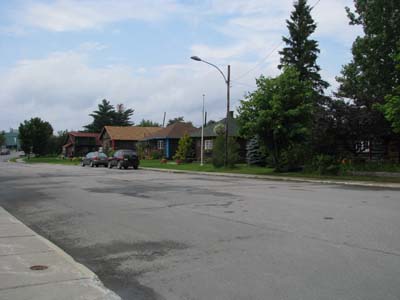The Former Lamaque Mine and the Bourlamaque Mining Village National Historic Site of Canada
Val-d’Or, Quebec

View of Perreault Street
© Agence Parcs Canada \ Parks Canada Agency, C. Cournoyer, 2009.
Address :
90 Perrault Avenue, Val-d’Or, Quebec
Recognition Statute:
Historic Sites and Monuments Act (R.S.C., 1985, c. H-4)
Designation Date:
2012-06-26
Dates:
-
1934 to 1934
(Construction)
-
1925 to 1925
(Established)
Event, Person, Organization:
-
Teck-Hugues (Company)
(Builder)
Other Name(s):
-
Former Lamaque Mine and the Bourlamaque Mining Village
(Designation Name)
-
Cité de l’Or
(Other Name)
Research Report Number:
2010-40 / 2010-40-A
Plaque(s)
Existing plaque: 90 Perrault Avenue, Val-d'Or, Quebec
Established at the height of the Great Depression, this site consists of a former mine and the part of Bourlamaque that was originally a mining village. Its numerous industrial and residential resources evoke the experience of the gold rush and life in a company town in Abitibi. In 1923, the promising discovery of a gold vein in the township of Bourlamaque led to the opening of a mine that, shortly after it was operational in 1935, became one of the most prolific in Quebec. To house their employees and create a well-planned settlement, Lamaque Gold Mines Limited constructed a company town. It had an orthogonal grid plan that expressed social hierarchy and established distinct zones of accommodation. Substantial homes were provided for managers and basic log houses for labourers. A well-preserved example of a mining landscape, the village and the former mine survived due to the efforts of local citizens, part of the movement in the 1960s and 1970s to conserve and protect Canada’s built heritage.
Commemorative Intent
The Former Lamaque Mine and the Bourlamaque Mining Village was designated as a national historic site because:
• it comprises a significant number of in situ industrial and residential resources, forming a well-preserved mining landscape suggestive of the gold rush that took place in northwestern Quebec, an important region in the history of Canadian mining;
• it is a rare and well-preserved example of a mining company town, a type of town that marked the development of many Canadian resource-based communities;
• it is an example of a planned single-industry town from the interwar years with features such as an orthogonal plan, residential land-use segregation according to social hierarchy, and harmonious architecture within each neighbourhood, which is highlighted by the contrast between the well-to-do houses of the mine’s management with the horizontal-log dwellings of its workers;
• it illustrates the community engagement that marked the Canadian heritage conservation movement in the 1960s and 1970s.